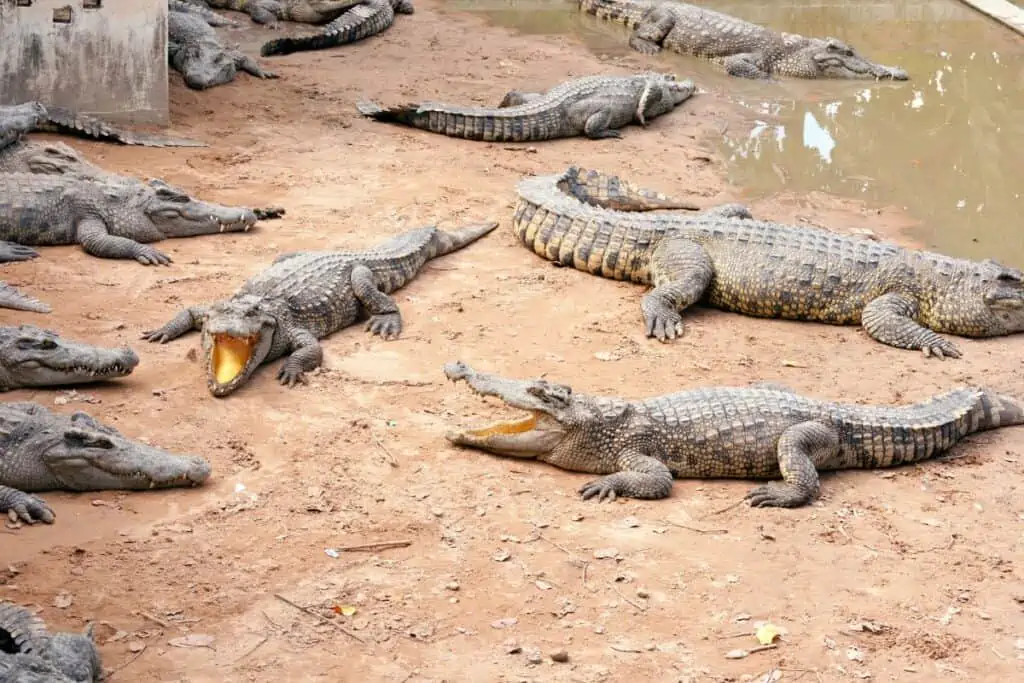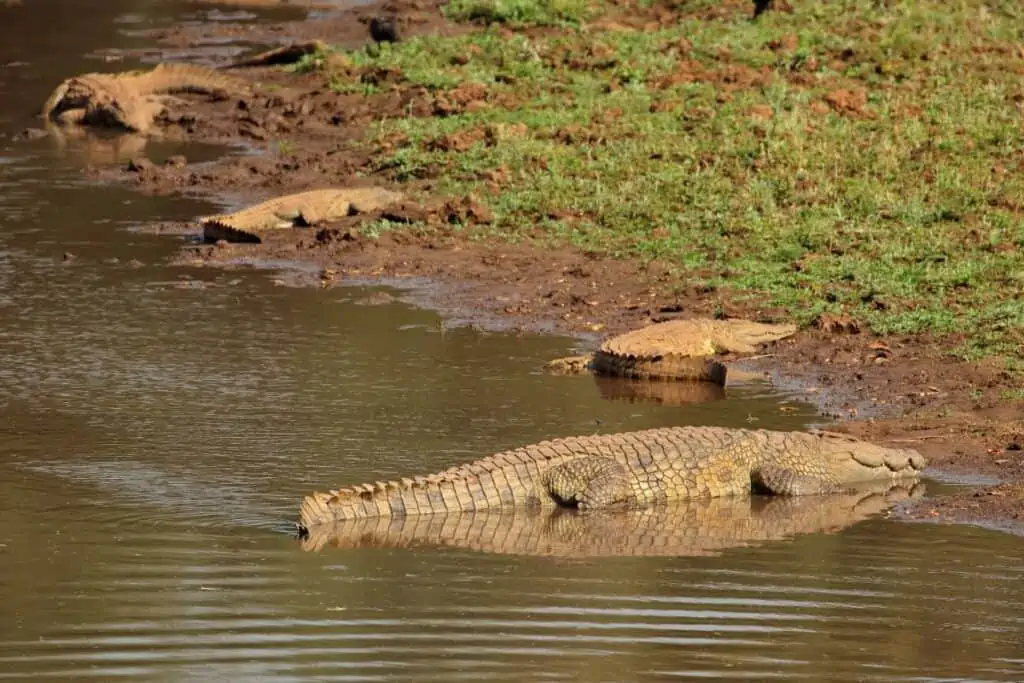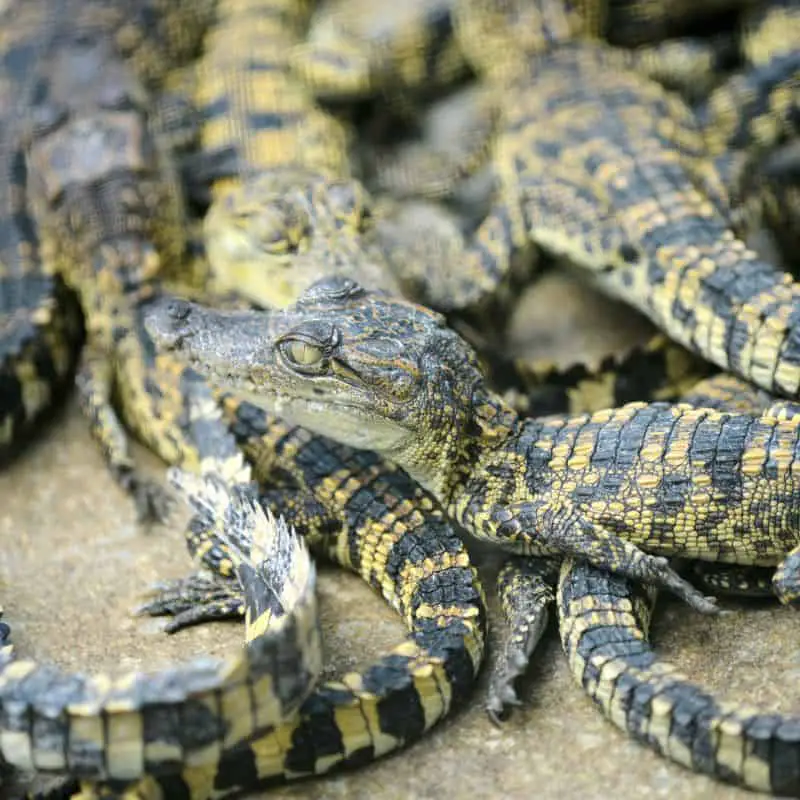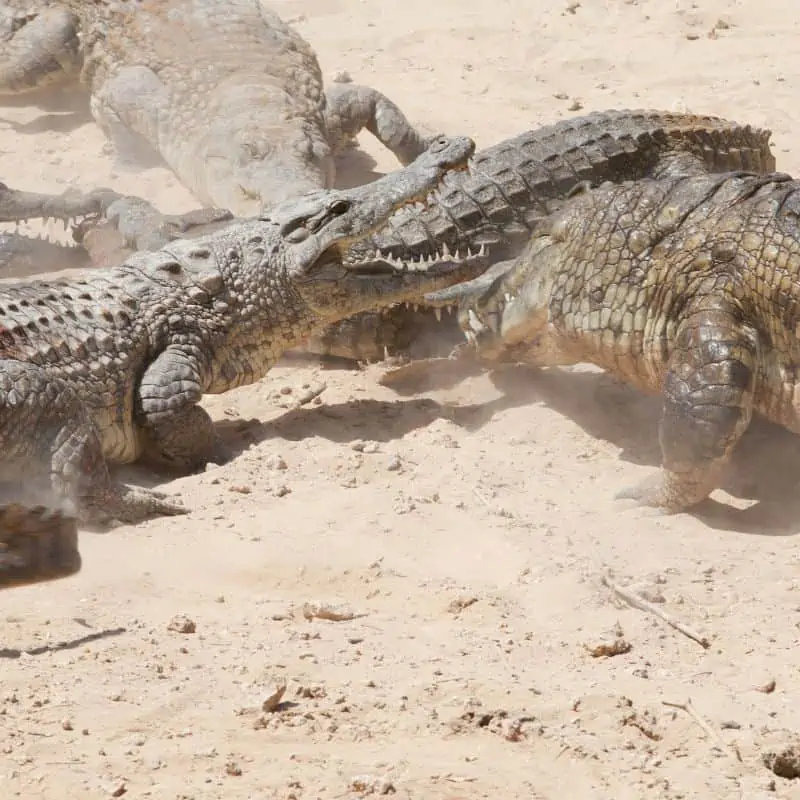Crocodiles can be social animals, more so than most reptiles, and can gather in groups of over 20. If you happen to come across this large gathering, how can you describe it? What is a group of crocodiles called?
The scientific family name for crocodiles is Crocodylidae, but English collective nouns differ depending on whether they are on land or in the water. A group of approximately twenty crocodiles together on land is known as a bask. In the water, they are called a float of crocodiles.
Watching a group of crocodiles lying in the sun for ages could lead you to believe they are docile. There are several reasons why crocodiles congregate in areas or tolerate each other; let’s take a deeper look.

What Is A Group Of Crocodiles Called?
A bask consists of around twenty crocodiles. Most groups are made up of males, females, and youngsters. Nile crocodiles tend to be more territorial, with only one dominant male and a few females and their young ones.
Crocodiles, like other reptilians, are cold-blooded animals that cannot regulate their body temperatures and rely on the outside temperatures to do it for them.
That’s why they lie basking in the sun. And since they usually do so in a group, it makes perfect sense to call a group of crocodiles a bask.
Research indicates that crocodiles’ temperatures vary continuously without staying at a preferred temperature. They return to the water in the afternoon before the air cools down too much.
They can spend up to two hours submerged in a body of water, completely immobile. A group of crocs in water is known as a float of crocodiles, and the term is self-explanatory.
Crocodiles seem to understand some principles that humans are only starting to learn: there’s safety in numbers, and more can be achieved if you work together. This is why they live in groups.
Crocodiles share duties in the group. Some will hunt while others rest. They have also been observed hunting cooperatively and sharing the food.
Crocodile mothers are very protective of their young, and sticking together in a group is best for the safety of all concerned.

Locations Of Groups Of Crocodiles
Most crocodiles dig dens a few feet under the ground, but the Nile crocodile can build their dens as deep as 39 feet down.
While some animals live in their dug-out dens, the Nile crocodile will only live in it while nesting between November and February.
At present, there are 18 extant (still alive today) species. They are mostly found in Asia, Africa, and Northern Australia. The largest group of Nile crocodiles is located in Central Africa.
The American crocodile is resident in Central America and northern South America.
But the only place in the USA that crocodiles call home is the southern point of Florida in the Everglades. It is also the only place worldwide where alligators and crocodiles live together.
Some countries highly sought after crocodile skins and products for handbags, accessories, and medicinal properties found in their blood and bile. To capitalize on this, several countries breed crocodiles on enormous farms.
Thailand is an example of this, with more than 1000 crocodile farms countrywide. One of their largest farms has 150,000 crocodiles.
Crocodile farming is illegal in the United States because the American crocodile is a threatened species. There are only about 2000 crocodiles in the USA.
A Bask Of Crocodiles Takes Turns Resting And Hunting
Crocodiles have been observed fishing together.
A bask will split itself into two; one group will work together to get fish while the other rests. The fishing group swims in a half-circle, chasing the fish towards the bank, where one croc will catch some lunch and join the resting group.
One of the crocs in the resting group will then swim in and help the fishing group until everyone has had a meal!
Crocodilians (which include crocodiles, caimans, gharials, and alligators) are also capable of coordinated and collaborative hunting on land, although it was commonly thought that they were only aquatic predators.
For example, studies by Dr. Vladimir Dinets reported that a saltwater crocodile was observed scaring a pig towards a lagoon where other crocodiles were waiting.
Baby Crocodiles Live Within The Group

Mother crocodiles lay their eggs in a large nest and will guard it for months until it’s time for the babies to hatch.
Nile crocodiles lay between 25 and 80 eggs, while Dwarf crocodiles only lay about ten. The mothers help the young ones hatch and then carry them down to the water in their mouths.
A group of crocodile hatchlings is called a crèche or a pod.
These little ones quickly learn to stay close to their mother for safety. The hatchlings shadow their moms for the first few months and venture further away, but they remain with the same bask for several years.
As the male’s age, they will leave and find a new bask to call home.
Crocodiles Sometimes Play Together
Well-documented research by Dr. Vladimir Dinets, who studied crocodilians for over a decade, indicates that crocodiles are more intelligent than we thought.
Behavioral scientists associate play with intelligence; these toothy reptiles love to play.
Dinets observed male crocodiles giving females rides on their backs during courtship in the Zoo Miami pools. He also watched younger ones taking piggyback rides with bigger adults.
Dinets also noted that crocodiles participate in all three types of play recognized in the animal kingdom: play with objects, social play, and locomotor play.
Crocodiles have been seen throwing sticks and food up in the air and playing with flowers and other random objects.
Piggybacking on other crocs is an example of social play, and locomotor play can be seen when they slide repetitively down a hill or play in a stream of water.
A Bask Of Crocodiles Is Not Always A Peaceful Place
Yes, crocodiles hunt together, rest together and protect their babies in a bask. But that doesn’t mean that peace always reigns.
Mating season can get tempers flaring, and crocs might contend for their territories or females.
They will attack the crocodile threatening their supremacy, and the loser will often end up as the winner’s dinner. That’s one way to ensure that your challenger doesn’t come back to bite you.

Fun Facts About Crocodiles
Some fun facts about crocodiles that you may not know:
- Saltwater crocodiles are the world’s largest reptiles. They can grow to 23 feet and can reach weights of 2200 pounds.
- Crocodile tears exist. These predators sometimes “cry” when eating their prey, but this could occur due to them hissing and huffing. As air is pushed through the sinuses, it may mix with tears in the tear glands, causing tears to flow.
- Nile crocodiles can live to 100 years, but a freshwater crocodile in the Australia Zoo lived to 140.
- Crocs can hold their breath for over an hour.
- Crocodiles sometimes swallow stones to aid digestion. Rocks in their stomachs help to crush their food.
Final Thoughts On Crocodile Groups
Crocodiles are one of the oldest reptiles to walk the earth.
They tend to congregate in groups of about 20, which we call a bask of crocodiles if they’re on land or a float of crocodiles if their activities are happening in the water.
If you get too close to a group of crocodiles, it is then called trouble.

